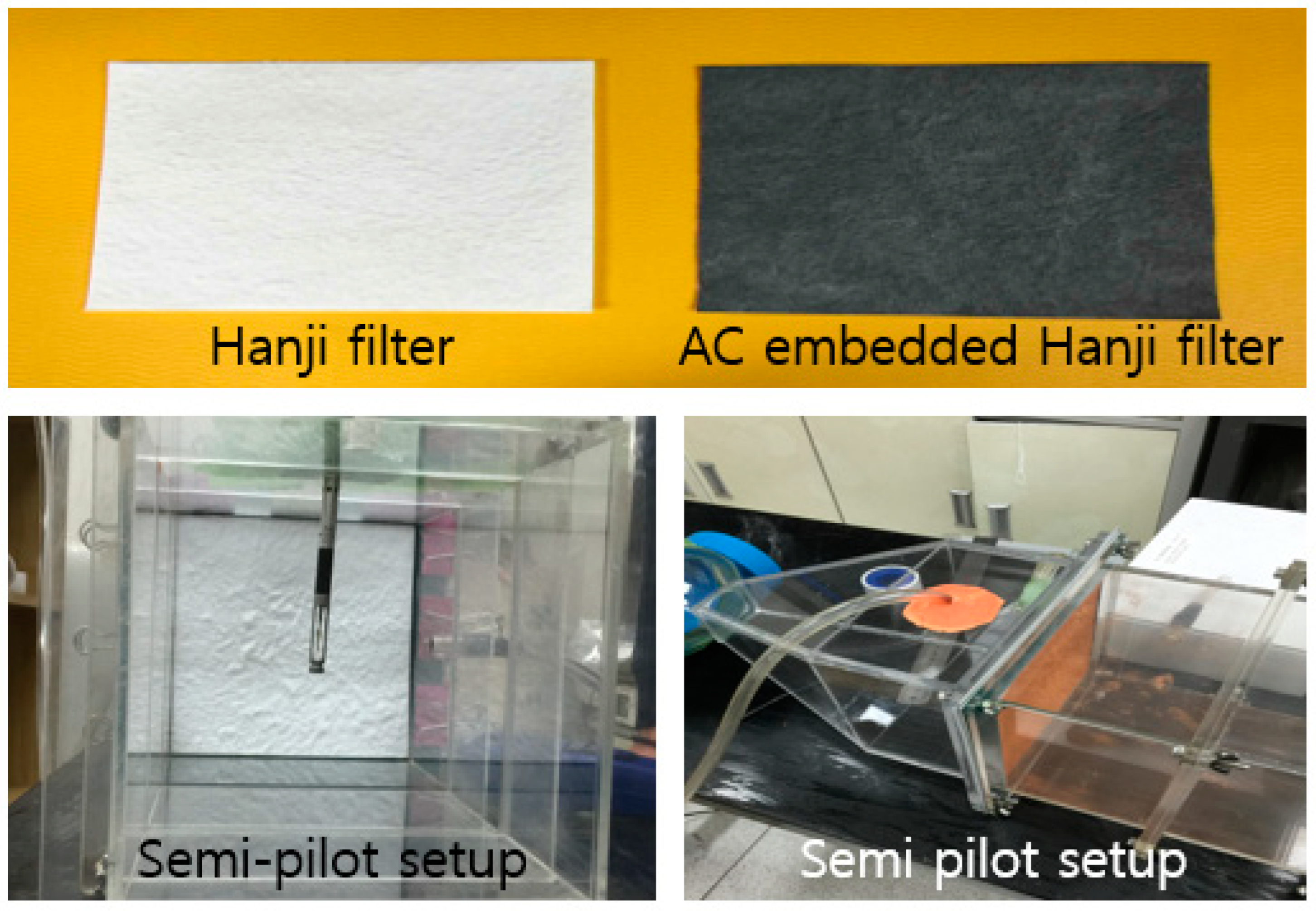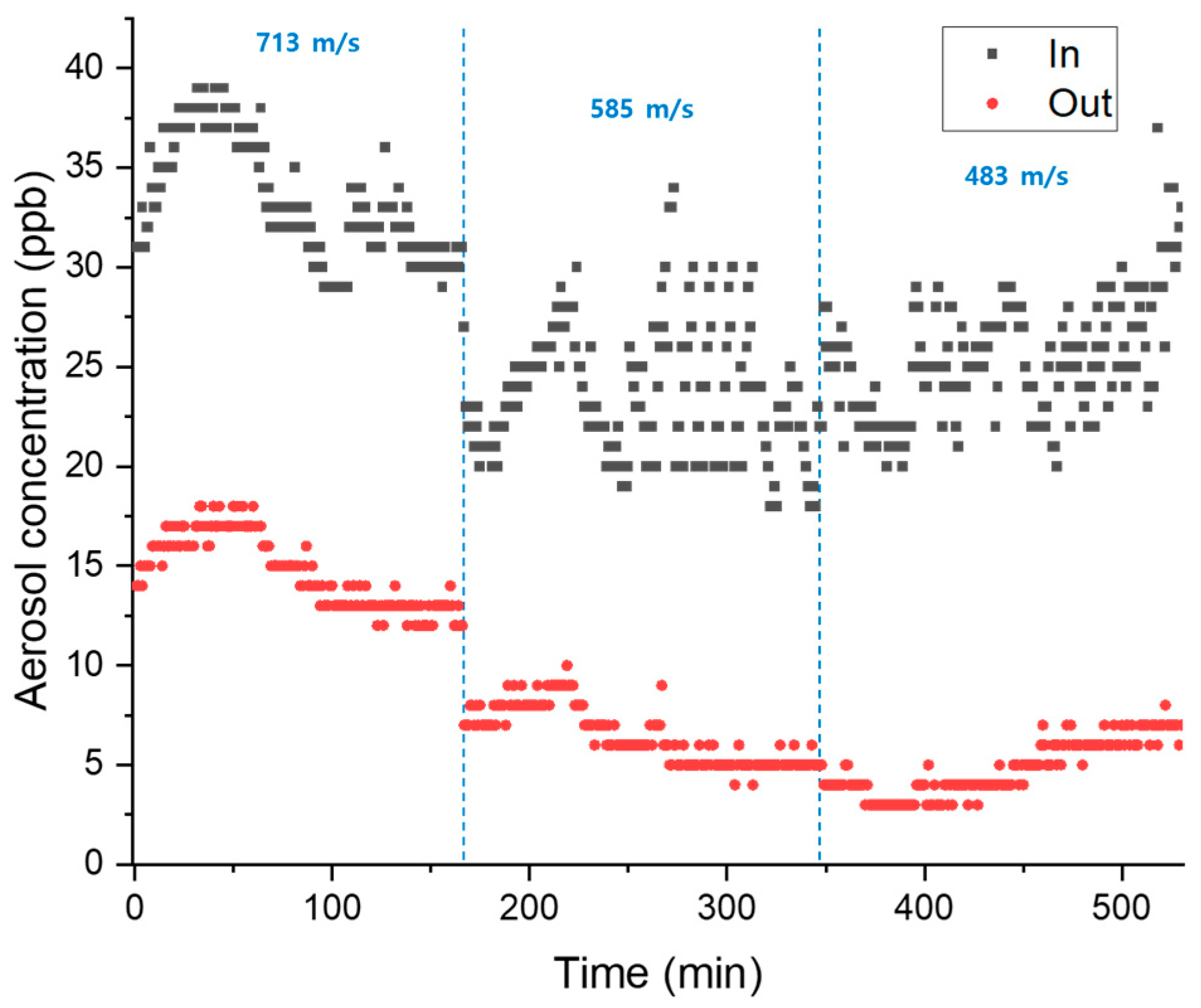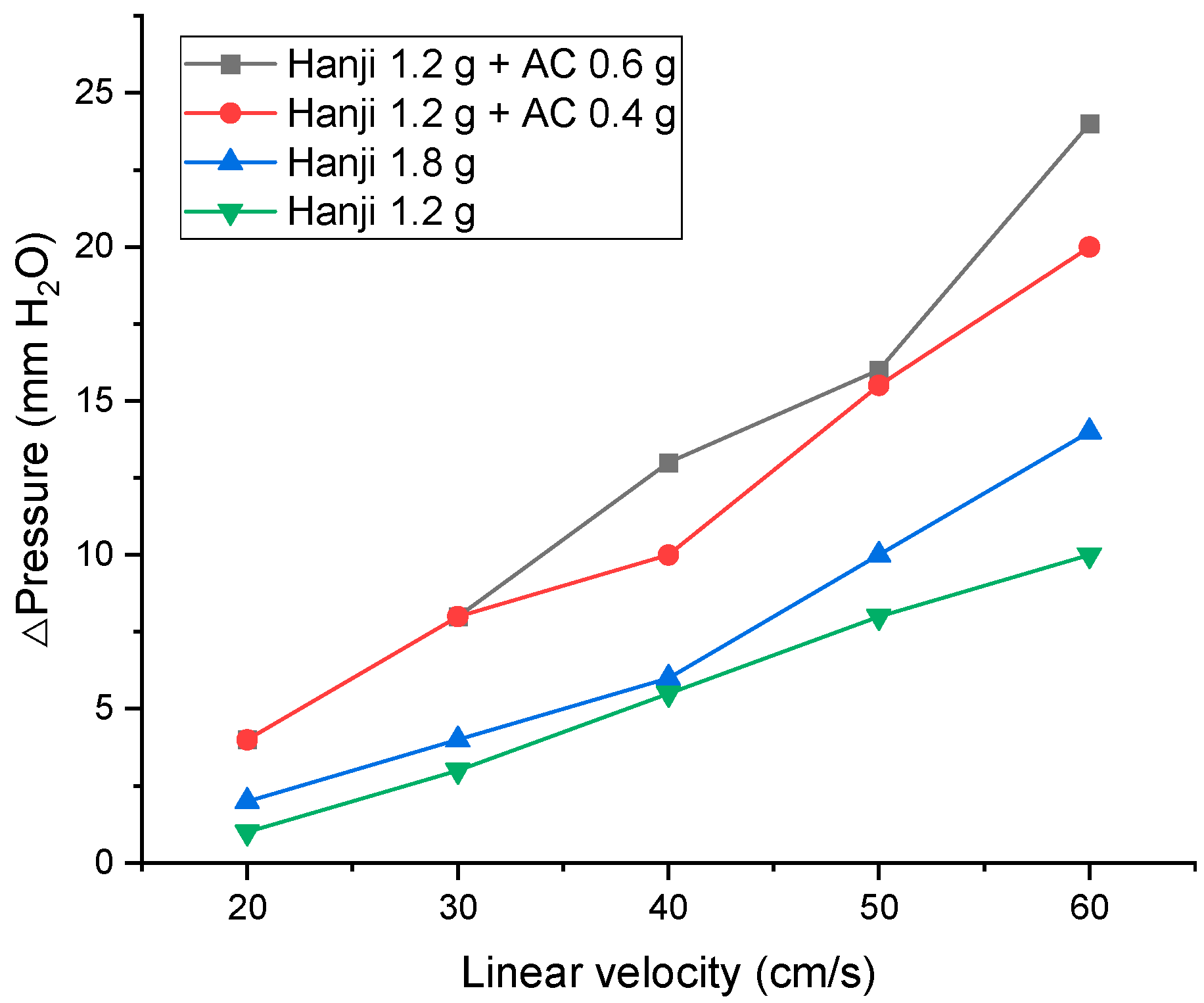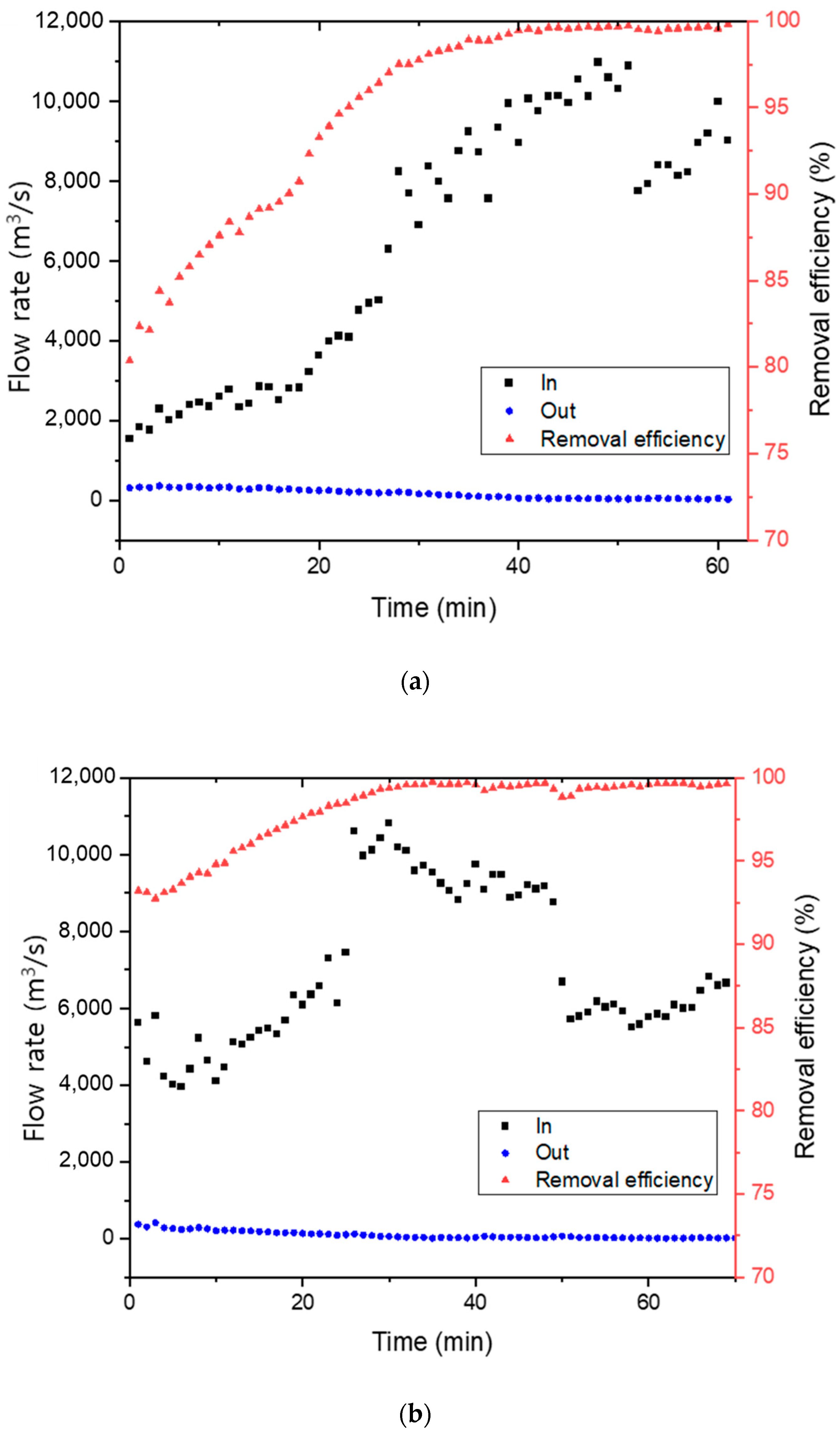Development of an Air Filter to Remove Fine Dust from Indoor Air Using a Traditional Korean Paper, ‘Hanji’
Abstract
1. Introduction
2. Materials and Methods
2.1. Experimental Materials (Hanji)
2.2. Production of the Hanji Filter
2.3. Setup for Calculation of the Operation Design Factors of the Hanji Filter
2.4. Production of Activated Carbon-Embedded Hanji Filter
2.5. Field Application as a Semi-Pilot Experiment
3. Results and Discussion
3.1. Characterization of the Manufactured Hanji Filter
3.2. Pressure Loss Changes According to the Linear Velocity of the AC-Embedded Hanji Filter
3.3. Hanji Filter for Fine Dust Removal
3.4. Fine Dust Filtration Efficiency of the AC-Embedded Hanji Filter
4. Conclusions
- (1)
- When producing the Hanji filter, the appropriate Hanji content per unit area to ensure porosity and minimal head loss was 51 g/m2. For the AC-embedded Hanji filter, the appropriate Hanji content per unit area was 31 g/m2, and the AC content was 31 g/m2.
- (2)
- The Hanji filter showed a removal efficiency of 80.4% within the first minute, 99.1% efficiency by the 38th minute, and maintained an efficiency of over 99% thereafter. The AC-embedded Hanji filter showed a removal rate of 93.2% within the first minute and 99.1% by the 28th minute. While the Hanji filter performed well, the dust removal efficiency of the AC-embedded Hanji filter proved to be superior.
- (3)
- The dust adhesion amount per unit area for both the Hanji filter and the AC-embedded Hanji filter varied depending on the Hanji and AC content, but on average, it was calculated to be ~20 g/m2.
Author Contributions
Funding
Institutional Review Board Statement
Informed Consent Statement
Data Availability Statement
Conflicts of Interest
References
- Wang, X.; Huang, J.; Ji, M.; Higuchi, K. Variability of East Asia dust events and their long-term trend. Atmos. Environ. 2008, 42, 3156–3165. [Google Scholar] [CrossRef]
- Zhai, S.; Jacob, D.J.; Pendergrass, D.C.; Colombi, N.K.; Shah, V.; Yang, L.H.; Zhang, Q.; Wang, S.; Kim, H.; Sun, Y. Coarse particulate matter air quality in East Asia: Implications for fine particulate nitrate. Atmos. Chem. Phys. 2023, 23, 4271–4281. [Google Scholar] [CrossRef]
- Zhang, D.; Li, H.; Luo, X.-S.; Huang, W.; Pang, Y.; Yang, J.; Tang, M.; Mehmood, T.; Zhao, Z. Toxicity assessment and heavy metal components of inhalable particulate matters (PM2. 5 & PM10) during a dust storm invading the city. Process Saf. Environ. Prot. 2022, 162, 859–866. [Google Scholar]
- do Nascimento, C.M.; de Oliveira, S.A.; Santana, O.A.; Carvalho, H. Changes in air pollution due to COVID-19 lockdowns in 2020: Limited effect on NO2, PM2. 5, and PM10 annual means compared to the new WHO Air Quality Guidelines. J. Glob. Health 2022, 12, 05043. [Google Scholar] [CrossRef] [PubMed]
- Mata, T.M.; Martins, A.A.; Calheiros, C.S.; Villanueva, F.; Alonso-Cuevilla, N.P.; Gabriel, M.F.; Silva, G.V. Indoor air quality: A review of cleaning technologies. Environments 2022, 9, 118. [Google Scholar] [CrossRef]
- Adebiyi, F.M. Air quality and management in petroleum refining industry: A review. Environ. Chem. Ecotoxicol. 2022, 4, 89–96. [Google Scholar] [CrossRef]
- de Almeida, D.S.; Martins, L.D.; Aguiar, M.L. Air pollution control for indoor environments using nanofiber filters: A brief review and post-pandemic perspectives. Chem. Eng. J. Adv. 2022, 11, 100330. [Google Scholar] [CrossRef]
- Osipov, S.; Chowdhury, S.; Crowley, J.N.; Tadic, I.; Drewnick, F.; Borrmann, S.; Eger, P.; Fachinger, F.; Fischer, H.; Predybaylo, E. Severe atmospheric pollution in the Middle East is attributable to anthropogenic sources. Commun. Earth Environ. 2022, 3, 203. [Google Scholar] [CrossRef]
- Chin, M.; Diehl, T.; Ginoux, P.; Malm, W. Intercontinental transport of pollution and dust aerosols: Implications for regional air quality. Atmos. Chem. Phys. 2007, 7, 5501–5517. [Google Scholar] [CrossRef]
- Kang, D.; Kim, J.-E. Fine, ultrafine, and yellow dust: Emerging health problems in Korea. J. Korean Med. Sci. 2014, 29, 621–622. [Google Scholar] [CrossRef]
- Liu, Y.; Zhou, B.; Wang, J.; Zhao, B. Health benefits and cost of using air purifiers to reduce exposure to ambient fine particulate pollution in China. J. Hazard. Mater. 2021, 414, 125540. [Google Scholar] [CrossRef] [PubMed]
- Cheek, E.; Guercio, V.; Shrubsole, C.; Dimitroulopoulou, S. Portable air purification: Review of impacts on indoor air quality and health. Sci. Total Environ. 2021, 766, 142585. [Google Scholar] [CrossRef] [PubMed]
- Fisk, W.J.; Faulkner, D. Performance and cost of particle air filtration technologies. Indoor Air 2001, 12, 1–16. [Google Scholar] [CrossRef] [PubMed]
- Li, P.; Wang, C.; Zhang, Y.; Wei, F. Air filtration in the free molecular flow regime: A review of high-efficiency particulate air filters based on carbon nanotubes. Small 2014, 10, 4543–4561. [Google Scholar] [CrossRef] [PubMed]
- Shao, Z.; Chen, H.; Wang, Q.; Kang, G.; Wang, X.; Li, W.; Liu, Y.; Zheng, G. High–Performance Multifunctional Electrospun Fibrous Air Filter for Personal Protection: A Review. Sep. Purif. Technol. 2022, 302, 122175. [Google Scholar] [CrossRef] [PubMed]
- Li, Y.; Yin, X.; Yu, J.; Ding, B. Electrospun nanofibers for high-performance air filtration. Compos. Commun. 2019, 15, 6–19. [Google Scholar] [CrossRef]
- Deng, Y.; Lu, T.; Cui, J.; Samal, S.K.; Xiong, R.; Huang, C. Bio-based electrospun nanofiber as building blocks for a novel eco-friendly air filtration membrane: A review. Sep. Purif. Technol. 2021, 277, 119623. [Google Scholar] [CrossRef]
- Bian, Y.; Zhang, C.; Wang, H.; Cao, Q. Degradable nanofiber for eco-friendly air filtration: Progress and perspectives. Sep. Purif. Technol. 2022, 306, 122642. [Google Scholar] [CrossRef]
- Fan, X.; Wang, Y.; Zhong, W.-H.; Pan, S. Hierarchically structured all-biomass air filters with high filtration efficiency and low air pressure drop based on pickering emulsion. ACS Appl. Mater. Interfaces 2019, 11, 14266–14274. [Google Scholar] [CrossRef]
- Lippi, M.; Riva, L.; Caruso, M.; Punta, C. Cellulose for the production of air-filtering systems: A critical review. Materials 2022, 15, 976. [Google Scholar] [CrossRef]
- Bonfim, D.P.; Cruz, F.G.; Bretas, R.E.; Guerra, V.G.; Aguiar, M.L. A sustainable recycling alternative: Electrospun PET-membranes for air nanofiltration. Polymers 2021, 13, 1166. [Google Scholar] [CrossRef] [PubMed]
- Choi, J.-I.; Chung, Y.J.; Lee, K.S.; Lee, J.-W. Effect of radiation on disinfection and mechanical properties of Korean traditional paper, Hanji. Radiat. Phys. Chem. 2012, 81, 1051–1054. [Google Scholar] [CrossRef]
- Yoon, S.-L.; Ra, J.-B. Orientation properties of Korean traditional paper-Hanji. J. Korea Tech. Assoc. Pulp Pap. Ind. 2013, 45, 52–58. [Google Scholar]
- Lee, Y.-R.; Kim, H.-W.; Lim, H.-A. A Study on the Design of Traditional Food Package Under the Use of Hanji (I)-Design of Korean dried confectionary package. J. Korea Tech. Assoc. Pulp Pap. Ind. 2007, 39, 68–77. [Google Scholar]
- Min-Jeong, S.; Hoon, S. An Experimental Study on the Effect of Hanji Windows on Indoor Air Temperature and Humidity Control. J. Korean Hous. Assoc. 2006, 17, 125–134. [Google Scholar]
- Jang, E.-S.; Kang, C.-W.; Kang, H.-Y.; Jang, S.-S. Sound absorption property of traditional Korean natural wallpaper (Hanji). J. Korean Wood Sci. Technol. 2018, 46, 703–712. [Google Scholar] [CrossRef]
- Kim, S.Y.; Yoon, Y.H.; Kim, K.S. Performance of activated carbon-impregnated cellulose filters for indoor VOCs and dust control. Int. J. Environ. Sci. Technol. 2016, 13, 2189–2198. [Google Scholar] [CrossRef][Green Version]
- d’Halluin, M.; Rull-Barrull, J.; Bretel, G.; Labrugère, C.; Le Grognec, E.; Felpin, F.X. Chemically modified cellulose filter paper for heavy metal remediation in water. ACS Sustain. Chem. Eng. 2017, 5, 1965–1973. [Google Scholar] [CrossRef]
- Wu, C.N.; Saito, T.; Fujisawa, S.; Fukuzumi, H.; Isogai, A. Ultrastrong and high gas-barrier nanocellulose/clay-layered composites. Biomacromolecules 2012, 13, 1927–1932. [Google Scholar] [CrossRef]
- Woo, H.J.; Ju, Y.C.; Park, S.C.; Lim, H.A.; Lee, H.H.; Choi, J.W.; Song, H.H.; Lee, Y.S. Studies on Physical Properties and Potential as Coffee Filter Application for Hanji According to Different Contents of Paper Mulberry Fibers. Korea Soc. Packag. Sci. Technol. 2020, 26, 33–39. [Google Scholar] [CrossRef]
- Yeo, M.J.; Kim, Y.P. Trends of the PM10 concentrations and high PM10 concentration cases in Korea. J. Korean Soc. Atmos. Environ. 2019, 35, 249–264. [Google Scholar] [CrossRef]
- Kwon, S.-B.; Park, D.-S.; Cho, Y.-M.; Kim, J.-B.; NanGoong, S.; Han, T.-W.; Cho, K.-H.; Kim, T.-S. Development of air cleaning roll-filter for improving IAQ in subway. J. Korean Soc. Railw. 2011, 14, 313–319. [Google Scholar] [CrossRef][Green Version]
- Poon, W.S.; Liu, B.Y. Dust Loading Behavior of Engine and General Purpose Air Cleaning Filters; 0148-7191; SAE Technical Paper: Warrendale, PA, USA, 1997. [Google Scholar][Green Version]
- Jokisch, S.; Neuenfeldt, M.; Scheibel, T. Silk-based fine dust filters for air filtration. Adv. Sustain. Syst. 2017, 1, 1700079. [Google Scholar] [CrossRef]
- Bulejko, P.; Krištof, O.; Dohnal, M. An Assessment on Average Pressure Drop and Dust-Holding Capacity of Hollow-Fiber Membranes in Air Filtration. Membranes 2021, 11, 467. [Google Scholar] [CrossRef] [PubMed]
- Endo, Y.; Chen, D.-R.; Pui, D.Y. Effects of particle polydispersity and shape factor during dust cake loading on air filters. Powder Technol. 1998, 98, 241–249. [Google Scholar] [CrossRef]
- Davies, C. The retention of particles in filters. J. Aerosol Sci. 1974, 5, 487–495. [Google Scholar] [CrossRef]
- Amin, A.; Merati, A.A.; Bahrami, S.H.; Bagherzadeh, R. Effects of porosity gradient of multilayered electrospun nanofibre mats on air filtration efficiency. J. Text. Inst. 2017, 108, 1563–1571. [Google Scholar] [CrossRef]
- Englesberg, J. Filtration—Theory and Practice. Ind. Eng. Chem. 1964, 56, 65–70. [Google Scholar] [CrossRef]
- Xi, J.; Gu, Z.; Cai, J.; Zhang, J.; Wang, H.; Wang, S. Filtration of dust in an electrostatically enhanced granular bed filter for high temperature gas cleanup. Powder Technol. 2020, 368, 105–111. [Google Scholar] [CrossRef]
- Park, O.; Park, M. Electrostatic enhancement of fine dust filtration in a granular bed filter. Environ. Eng. Res. 2001, 6, 109–116. [Google Scholar]
- Roegiers, J.; Denys, S. Development of a novel type activated carbon fiber filter for indoor air purification. Chem. Eng. J. 2021, 417, 128109. [Google Scholar] [CrossRef]
- Mondal, S.; De, S.; Saha, P. Removal of VOCs and improvement of indoor air quality using activated carbon air filter. In Advances in Structural Technologies: Select Proceedings of CoAST 2019; Springer: Berlin/Heidelberg, Germany, 2020; pp. 123–132. [Google Scholar]
- Yang, S.; Zhu, Z.; Wei, F.; Yang, X. Carbon nanotubes/activated carbon fiber based air filter media for simultaneous removal of particulate matter and ozone. Build. Environ. 2017, 125, 60–66. [Google Scholar] [CrossRef]










| Design Factors | Criterion Value | Note |
|---|---|---|
| Linear velocity | 7 cm/s | |
| Thickness of Hanji | 0.8 mm | |
| Porosity of Hanji | 90% | |
| Content of Hanji | 7.4 mg/cm2 | |
| Amount of fine dust adhesions | 3.6 g/cm2 | Head loss: 25 mm H2O Fine dust size: >PM5 |
| Sample Name (Content Mass) | Filter Weight | Filter Weight after Dust Adhesion | Weight of Adhered Dust |
|---|---|---|---|
| Hanji (1.2 g) | 3.8893 | 4.6346 | 0.7453 |
| Hanji (1.8 g) | 4.5166 | 5.1384 | 0.6218 |
| Hanji (1.2 g) + AC (0.4 g) | 4.5945 | 5.1410 | 0.5465 |
| Hanji (1.8 g) + AC (0.6 g) | 4.7115 | 5.4153 | 0.7038 |
| Average weight of adhered dust: 0.6543 g Average adhered fine dust per unit area of filter samples: 0.65435 g/324 cm2 = 2 mg/cm2 (20 g/m2) | |||
Disclaimer/Publisher’s Note: The statements, opinions and data contained in all publications are solely those of the individual author(s) and contributor(s) and not of MDPI and/or the editor(s). MDPI and/or the editor(s) disclaim responsibility for any injury to people or property resulting from any ideas, methods, instructions or products referred to in the content. |
© 2023 by the authors. Licensee MDPI, Basel, Switzerland. This article is an open access article distributed under the terms and conditions of the Creative Commons Attribution (CC BY) license (https://creativecommons.org/licenses/by/4.0/).
Share and Cite
Baek, S.; Kim, S.; Yoon, Y.; Kim, K.S.; Bae, J. Development of an Air Filter to Remove Fine Dust from Indoor Air Using a Traditional Korean Paper, ‘Hanji’. Sustainability 2024, 16, 179. https://doi.org/10.3390/su16010179
Baek S, Kim S, Yoon Y, Kim KS, Bae J. Development of an Air Filter to Remove Fine Dust from Indoor Air Using a Traditional Korean Paper, ‘Hanji’. Sustainability. 2024; 16(1):179. https://doi.org/10.3390/su16010179
Chicago/Turabian StyleBaek, Soyoung, Suho Kim, Younghan Yoon, Kwang Soo Kim, and Jiyeol Bae. 2024. "Development of an Air Filter to Remove Fine Dust from Indoor Air Using a Traditional Korean Paper, ‘Hanji’" Sustainability 16, no. 1: 179. https://doi.org/10.3390/su16010179
APA StyleBaek, S., Kim, S., Yoon, Y., Kim, K. S., & Bae, J. (2024). Development of an Air Filter to Remove Fine Dust from Indoor Air Using a Traditional Korean Paper, ‘Hanji’. Sustainability, 16(1), 179. https://doi.org/10.3390/su16010179






